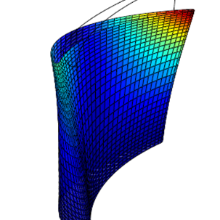Analysis of forced response in radial turbines
Forced response blade vibrations, which under certain circumstances can lead to fatigue failure, are investigated numerically in a turbocharger turbine. The focus is on the transient fluid forces which excite the structure. These are numerically calculated by means of detail-resolved 3D flow simulations and their interaction with the blades is investigated. Standard models such as URANS-simulations as well as novel approaches such as the frequency-based NLH (Non-Linear -Harmonic) method are used and extensively validated with measurement data.
Determination of the aerodynamic damping of axial compressors
In power plants and aircraft engines, axial compressors are usually used. Here, as well, the investigation of blade vibrations is essential for the safe operation of the entire turbomachine. Various components in the flow channel, such as adjacent stator rows, generate fluctuations in the pressure field of the flow. These can excite vibrations in the rotors, and if the overall damping of the rotor is low, this can lead to component failure.
The ACTIVE (Axial Compressor Test Rig for the Investigation of Blisk Vibrations with an Active Excitation System) test rig was developed at ITSM to investigate aerodynamic damping and to further develop numerical prediction methods. Here, the rotor is specifically excited to vibrate using electromagnets. Laser-based blade tip timing (BTT) sensors then enable high-quality damping determination.
Prediction of the flutter susceptibility of steam turbine rotors
Extremely high power is converted in the final stages of steam turbines. The rotor blades are exposed to special conditions. The expansion to very low pressures can cause water droplets to form. In addition, due to the extreme density reduction, the blades must be very long, usually over 1 meter. The combination of high flow velocities and long, thin blades therefore makes the blading prone to the occurrence of blade flutter. A core aspect of predicting these flutter phenomena is the determination of aerodynamic damping employing numerical tools. Unsteady flow simulations with consideration of fluid-structure interaction are used to determine the damping for the low-frequency eigenmodes of the blade.
Influence of condensing steam flows on the flutter susceptibility of steam turbine blades
In the last stages of steam turbines, expansion into the two-phase region results in the formation of water droplets within the flow. This condensation process alters the expansion course by releasing heat. This in turn has an influence on the aerodynamic damping and thus the flutter behavior of rotor blades in steam turbine last stages. The effect of droplet size and number on damping is investigated in detail by using sophisticated wet steam models within CFD-simulations.



